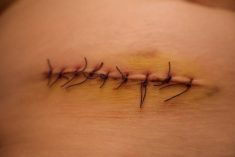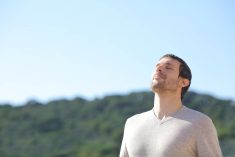You’ve probably heard someone say that they hold all their tension in their shoulders and neck, and that’s not uncommon. Environmental and emotional stress often shows up in our posture, and often in our upper shoulders, neck and even our face and jaw.
For the vast majority of us in one way or another, the past couple of years have come with plenty of environmental stressors. One commonly felt one is the effect of consistent mask use, which can be an adjustment and sometimes an extra stressor on the soft tissues and nerves of the face.
Read Also

Gentle treatments for pain in the neck
Heading toward year-end, people unknowingly tense up against the cold and busyness, causing neck pain that can often be treated with appropriate support and gentle mobility, athletic therapist Kathlyn Hossack says.
Another trigger for upper body, neck and face tension can be as simple as seasonal changes. As the weather gets colder we naturally tend to elevate our shoulders and wear more clothing as a result. The weather is outside of our control, but there are some small, simple things you can do to help relieve some tension, headaches or sinus pressure if you’re noticing an increase in discomfort through your upper body during this season.
For these self-treatments all you’ll need are your hands and a comfortable place to sit or lay down. This self-treatment is largely pressure point based and can be done to help shift sinus pressure, headaches, or discomfort related to changes in attire or environment.
To start, find a comfortable, supported position either seated with the feet resting on the ground, or laying on your back supported in a way that is comfortable for you. Take one hand on either side of your head and find your temple. Using your index or middle finger, apply light to medium pressure on your temple via the finger pads and move in small, clockwise circles slowly. Keep pressure through the finger so that the skin of your temple moves with your fingers in the circle. If there is some tenderness as you do this on one side or the other, this is OK as long as it is a tolerable sensation for a few moments. After 10 to 20 circles clockwise, repeat the exercise counter-clockwise. You may find certain points around the circle where there is more tenderness. Pause with pressure on that point while taking a few deep breaths before continuing.
After moving in both directions at the temples, let your fingers slide down the line of your jaw until you find the space between your earlobe and your jawbone on either side. On this point keep light pressure only and do the same clockwise and then counter-clockwise circles for 10 to 15 times in each direction. Keep taking deep breaths as you move.
After circling at the jaw, slide your fingers under your ear and lightly draw circles in an upward trajectory on the tissues around the back of your ear. Follow the shape of your ear up and down about 10 times using this circular movement and light pressure.
Next, take your thumbs and place them lightly on either side of the bridge of your nose. Slide them upwards until you reach your brow bone. This is often a tender spot for many people; gently apply pressure at the curve of the brow bone, and take about 10 big deep breaths.
From here, take your thumbs on either side of the underside of your chin and gently trace along the underside of your jawbone until you reach the earlobe. Repeat this five to 10 times with gentle pressure. Now, use the palm of your hand to slide from jawbone down the neck to the collarbone for five to 10 times.
Repeat this series one to three times as needed. Remember to keep breathing and move intentionally! If you have pain, tension or other symptoms in your upper body that last for longer than a few days, seek advice from your regular health-care professional or local wellness professional as soon as possible. Self-treatments are an excellent self-care practice and seeking assistance and guidance from a qualified and caring professional only enhances that self-care.















